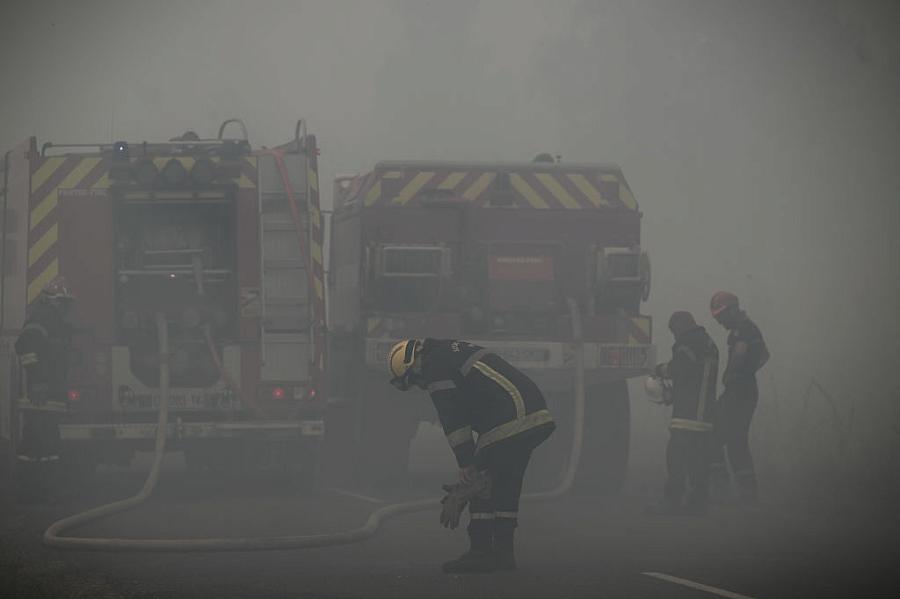The dangers posed by wildfire smoke to workers seemed like a stale story. I happily proved myself wrong.

(Photo by Philippe Lopez/AFP via Getty Images)
The question kept lingering in the back of my mind: What’s new about this story?
The issues surrounding safety and wildfires have been rehashed and examined many times, especially in the five years following 2017’s deadly fire storm in Sonoma County.
As I began to put many of the same questions to experts and listen to many similar accounts about the harrowing experiences and dangers of working during wildfires and smoke events as a Center for Health Journalism 2022 California Fellow, I began to feel that I had chosen to research a played-out topic. Others had already written all there was to say it seemed, a feeling that was only reinforced as local government actions to address the plight of workers in smoky conditions, preempting my reporting.
As an inexperienced reporter, taking on a large investigative project was already a daunting task, but as I dove into new conversations with farmworkers, interviews with doctors and elected officials, the importance of the topic became more clear and relevant. Just because a story isn’t new doesn’t mean it isn’t important.
The words of one county supervisor hammered home that point: “We've heard over and over again that even though all of the rules are already on the books … those (rules) are violated.”
Wildfires devastated Sonoma County and battered the agricultural sector and its workers in 2017, 2019, and 2020. Even when fires are far off, smoke can easily carry hundreds of miles. UC Irvine’s Michael Mendez, who investigated the ad hoc evacuation zone work program which served as a flash point between local activists and industry leaders, outlined the relevancy of the story, and why it is such a contentious one:
“Disproportionately, hundreds of these farm workers and a majority of them undocumented farm workers were entering into these mandatory evacuation zones with lack of government oversights. There was really no follow-up or understanding of how many people were actually going into these evacuation zones on a daily basis, their duration and what sort of conditions they were experiencing out there in the job sites.”
By now nearly anyone living in the Western U.S. knows the threat wildfire smoke poses to one’s health, but what exactly does it mean for farmworkers or anyone else exposed for long periods of time?
-
Upper respiratory infections, asthma, COPD — the risk of these conditions increases with exposure to wildfire smoke (PM 2.5) pollution
-
Hospital admissions for respiratory issues increased by up to 10% during wildfire smoke events compared to similar PM 2.5 pollution levels from other sources.
-
Wildfire smoke is three to four times more harmful to the respiratory tract than ambient particulate matter pollution.
Parts of Sonoma County have experienced at least 24 days of hazardous air quality since 2017, a number that still means those working outside in the smoky conditions are left vulnerable to a wide range of potentially long-lasting health effects from repeat exposures.
There has been a great amount of movement to protect vulnerable workers both statewide and locally. In Sonoma County, the adoption of an Agricultural Access Pass occurred just weeks before publication of my reporting, and put into law a number of protections for workers like mandating access to masks and respirators under certain conditions, restricting work within evacuation zones, and providing avenues for reporting of workplace safety violations. Many similar protections are also part of California-wide regulations through measures like this year’s Assembly Bill 2243, which lowers the threshold at which respirators must be provided to workers from 500 on the air quality index to 301.
These protections are driven by the experiences like that of one vineyard worker who “had to work directly in the smoke” and related how during one moment when they were picking grapes, “it almost felt like the ash was part of the grape while we were picking.” Another worker said he felt they were “treated more as things than actual people.”
Besides the standard lessons of time management, finding sources and subjects, and pouring through pages of government data, taking an investigative dive into the true costs of normalized danger from California’s fires serves to remind us of the importance of keeping with a story, even one that feels played out, when people’s health is on the line. Inertia can be the name of the game on health issues. What often begins as an uphill battle by concerned community members and those affected by hazards like wildfire smoke can, with sustained reporting, turn into a success story where the needs of vulnerable people are acknowledged and met.

